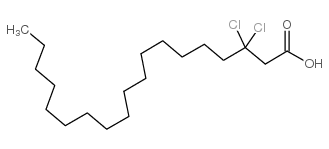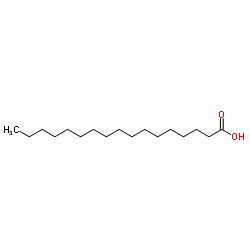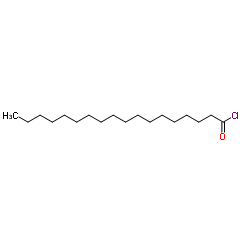2,2-Dichlorooctadecanoic acid
Modify Date: 2024-01-09 15:40:44

2,2-Dichlorooctadecanoic acid structure
|
Common Name | 2,2-Dichlorooctadecanoic acid | ||
|---|---|---|---|---|
| CAS Number | 56279-50-6 | Molecular Weight | 367.39400 | |
| Density | N/A | Boiling Point | N/A | |
| Molecular Formula | C19H36Cl2O2 | Melting Point | N/A | |
| MSDS | N/A | Flash Point | N/A | |
| Name | 2,2-Dichlorooctadecanoic acid |
|---|---|
| Synonym | More Synonyms |
| Molecular Formula | C19H36Cl2O2 |
|---|---|
| Molecular Weight | 367.39400 |
| Exact Mass | 366.20900 |
| PSA | 37.30000 |
| LogP | 7.50640 |
Synonym:None Section 2 - COMPOSITION, INFORMATION ON INGREDIENTS
Risk Phrases: 34 Section 3 - HAZARDS IDENTIFICATION EMERGENCY OVERVIEW
Causes burns.Corrosive. Potential Health Effects Eye: Causes eye burns. Skin: Causes skin burns. Ingestion: Causes gastrointestinal tract burns. Inhalation: Causes chemical burns to the respiratory tract. Chronic: No information found. Section 4 - FIRST AID MEASURES Eyes: Immediately flush eyes with plenty of water for at least 15 minutes, occasionally lifting the upper and lower eyelids. Get medical aid immediately. Skin: Get medical aid. Immediately flush skin with plenty of water for at least 15 minutes while removing contaminated clothing and shoes. Ingestion: Do not induce vomiting. If victim is conscious and alert, give 2-4 cupfuls of milk or water. Never give anything by mouth to an unconscious person. Get medical aid immediately. Inhalation: Get medical aid immediately. Remove from exposure and move to fresh air immediately. If not breathing, give artificial respiration. If breathing is difficult, give oxygen. Notes to Physician: Section 5 - FIRE FIGHTING MEASURES General Information: As in any fire, wear a self-contained breathing apparatus in pressure-demand, MSHA/NIOSH (approved or equivalent), and full protective gear. Extinguishing Media: Use foam, dry chemical, or carbon dioxide. Section 6 - ACCIDENTAL RELEASE MEASURES General Information: Use proper personal protective equipment as indicated in Section 8. Spills/Leaks: Vacuum or sweep up material and place into a suitable disposal container. Reduce airborne dust and prevent scattering by moistening with water. Clean up spills immediately, observing precautions in the Protective Equipment section. Section 7 - HANDLING and STORAGE Handling: Wash thoroughly after handling. Wash hands before eating. Remove contaminated clothing and wash before reuse. Use with adequate ventilation. Do not breathe dust, vapor, mist, or gas. Do not get in eyes, on skin, or on clothing. Do not ingest or inhale. Storage: Store in a cool, dry place. Store in a tightly closed container. Corrosives area. Section 8 - EXPOSURE CONTROLS, PERSONAL PROTECTION Engineering Controls: Use adequate general or local exhaust ventilation to keep airborne concentrations below the permissible exposure limits. Exposure Limits CAS# 56279-50-6: Personal Protective Equipment Eyes: Wear appropriate protective eyeglasses or chemical safety goggles as described by OSHA's eye and face protection regulations in 29 CFR 1910.133 or European Standard EN166. Skin: Wear appropriate protective gloves to prevent skin exposure. Clothing: Wear appropriate protective clothing to prevent skin exposure. Respirators: Follow the OSHA respirator regulations found in 29 CFR 1910.134 or European Standard EN 149. Use a NIOSH/MSHA or European Standard EN 149 approved respirator if exposure limits are exceeded or if irritation or other symptoms are experienced. Section 9 - PHYSICAL AND CHEMICAL PROPERTIES Physical State: Solid Color: slightly yellow Odor: Not available. pH: Not available. Vapor Pressure: Not available. Viscosity: Not available. Boiling Point: Not available. Freezing/Melting Point: 40 - 43 deg C Autoignition Temperature: Not available. Flash Point: 180 deg C ( 356.00 deg F) Explosion Limits, lower: Not available. Explosion Limits, upper: Not available. Decomposition Temperature: 180 deg C Solubility in water: Specific Gravity/Density: Molecular Formula: C18H34Cl2O2 Molecular Weight: 353.36 Section 10 - STABILITY AND REACTIVITY Chemical Stability: Stable under normal temperatures and pressures. Conditions to Avoid: Incompatible materials. Incompatibilities with Other Materials: Strong oxidizing agents. Hazardous Decomposition Products: Hydrogen chloride, carbon monoxide, carbon dioxide. Hazardous Polymerization: Has not been reported. Section 11 - TOXICOLOGICAL INFORMATION RTECS#: CAS# 56279-50-6 unlisted. LD50/LC50: Not available. Carcinogenicity: 2,2-Dichlorooctadecanoic acid, 90% - Not listed by ACGIH, IARC, or NTP. Section 12 - ECOLOGICAL INFORMATION Section 13 - DISPOSAL CONSIDERATIONS Dispose of in a manner consistent with federal, state, and local regulations. Section 14 - TRANSPORT INFORMATION IATA Shipping Name: CORROSIVE SOLID, ACIDIC, ORGANIC, N.O.S.* Hazard Class: 8 UN Number: 3261 Packing Group: III IMO Shipping Name: CORROSIVE SOLID, N.O.S. Hazard Class: 8 UN Number: 3261 Packing Group: III RID/ADR Shipping Name: CORROSIVE SOLID, ACIDIC, ORGANIC, N.O.S. Hazard Class: 8 UN Number: 3261 Packing group: III Section 15 - REGULATORY INFORMATION European/International Regulations European Labeling in Accordance with EC Directives Hazard Symbols: C Risk Phrases: R 34 Causes burns. Safety Phrases: S 26 In case of contact with eyes, rinse immediately with plenty of water and seek medical advice. S 36/37/39 Wear suitable protective clothing, gloves and eye/face protection. S 45 In case of accident or if you feel unwell, seek medical advice immediately (show the label where possible). WGK (Water Danger/Protection) CAS# 56279-50-6: No information available. Canada None of the chemicals in this product are listed on the DSL/NDSL list. CAS# 56279-50-6 is not listed on Canada's Ingredient Disclosure List. US FEDERAL TSCA CAS# 56279-50-6 is not listed on the TSCA inventory. It is for research and development use only. SECTION 16 - ADDITIONAL INFORMATION N/A |
|
~76% 
2,2-Dichlorooct... CAS#:56279-50-6 |
| Literature: Buyck, L. De; Casaert, F.; Lepeleire, C. De; Schamp, N. Bulletin des Societes Chimiques Belges, 1988 , vol. 97, # 7 p. 525 - 534 |
|
~% 
2,2-Dichlorooct... CAS#:56279-50-6 |
| Literature: v. Braun Justus Liebigs Annalen der Chemie, 1931 , vol. 490, p. 100,132 |
|
~% 
2,2-Dichlorooct... CAS#:56279-50-6 |
| Literature: Buyck, L. De; Casaert, F.; Lepeleire, C. De; Schamp, N. Bulletin des Societes Chimiques Belges, 1988 , vol. 97, # 7 p. 525 - 534 |
|
~% 
2,2-Dichlorooct... CAS#:56279-50-6 |
| Literature: Stevens, Christian; De Buyck, Laurent; De Kimpe, Norbert Tetrahedron Letters, 1998 , vol. 39, # 47 p. 8739 - 8742 |
|
~% 
2,2-Dichlorooct... CAS#:56279-50-6 |
| Literature: v. Braun Justus Liebigs Annalen der Chemie, 1931 , vol. 490, p. 100,132 |
|
~% 
2,2-Dichlorooct... CAS#:56279-50-6 |
| Literature: v. Braun Justus Liebigs Annalen der Chemie, 1931 , vol. 490, p. 100,132 |
|
~% 
2,2-Dichlorooct... CAS#:56279-50-6 |
| Literature: v.Braun; Jostes; Muench Justus Liebigs Annalen der Chemie, 1927 , vol. 453, p. 134 |
|
~% 
2,2-Dichlorooct... CAS#:56279-50-6 |
| Literature: v.Braun; Jostes; Muench Justus Liebigs Annalen der Chemie, 1927 , vol. 453, p. 134 |
|
~% 
2,2-Dichlorooct... CAS#:56279-50-6 |
| Literature: v. Braun Justus Liebigs Annalen der Chemie, 1931 , vol. 490, p. 100,132 |
| Octadecanoic acid,dichloro |
| 2,2-DICHLORO-1,4-BUTANEDIOL |
| 2,2-Dichlor-octadecansaeure |
| Dihydrooctadecanoic acid |
| 2,2-dichloro-octadecanoic acid |










